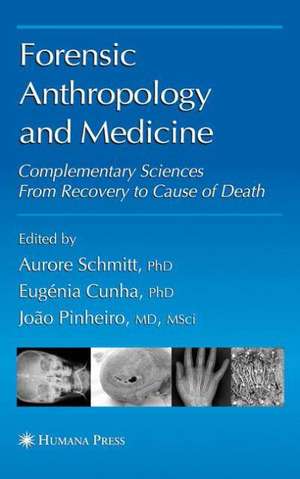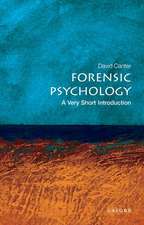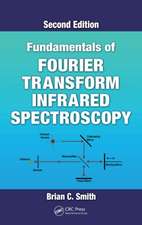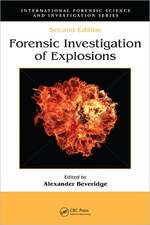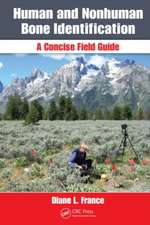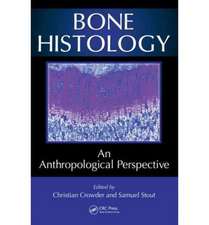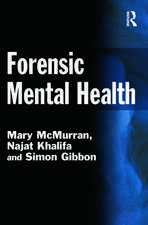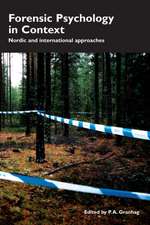Forensic Anthropology and Medicine: Complementary Sciences From Recovery to Cause of Death
Editat de Aurore Schmitten Limba Engleză Paperback – 5 noi 2010
| Toate formatele și edițiile | Preț | Express |
|---|---|---|
| Paperback (1) | 1421.06 lei 6-8 săpt. | |
| Humana Press Inc. – 5 noi 2010 | 1421.06 lei 6-8 săpt. | |
| Hardback (1) | 1428.91 lei 6-8 săpt. | |
| Humana Press Inc. – iun 2006 | 1428.91 lei 6-8 săpt. |
Preț: 1421.06 lei
Preț vechi: 1495.85 lei
-5% Nou
Puncte Express: 2132
Preț estimativ în valută:
272.01€ • 295.56$ • 228.63£
272.01€ • 295.56$ • 228.63£
Carte tipărită la comandă
Livrare economică 21 aprilie-05 mai
Preluare comenzi: 021 569.72.76
Specificații
ISBN-13: 9781617377921
ISBN-10: 1617377929
Pagini: 480
Ilustrații: 480 p. 197 illus.
Dimensiuni: 152 x 229 x 27 mm
Greutate: 0.7 kg
Ediția:Softcover reprint of hardcover 1st ed. 2006
Editura: Humana Press Inc.
Colecția Humana
Locul publicării:Totowa, NJ, United States
ISBN-10: 1617377929
Pagini: 480
Ilustrații: 480 p. 197 illus.
Dimensiuni: 152 x 229 x 27 mm
Greutate: 0.7 kg
Ediția:Softcover reprint of hardcover 1st ed. 2006
Editura: Humana Press Inc.
Colecția Humana
Locul publicării:Totowa, NJ, United States
Public țintă
Professional/practitionerCuprins
Two Sciences, One Objective.- to Forensic Anthropology.- to Forensic Medicine and Pathology.- Forensic Anthropology and Forensic Pathology.- Aging Living Young Individuals.- Biological vs Legal Age of Living Individuals.- Pathophysiology of Death and Forensic Investigation: From Recovery to Cause of Death.- Decay Process of a Cadaver.- Understanding the Circumstances of Decomposition When the Body Is Skeletonized.- Forensic Investigation of Corpses in Various States of Decomposition.- Identification and Differential Diagnosis of Traumatic Lesions of the Skeleton.- Biological Identity.- Methodology and Reliability of Sex Determination From the Skeleton.- Age Assessment of Child Skeletal Remains in Forensic Contexts.- Determination of Adult Age at Death in the Forensic Context.- Is It Possible to Escape Racial Typology in Forensic Identification?.- Estimation and Evidence in Forensic Anthropology.- Pathology as a Factor of Personal Identity in Forensic Anthropology.- Personal Identification of Cadavers and Human Remains.- Particular Contexts: Crimes Against Humanity and Mass Disasters.- Forensic Investigations Into the Missing.- Crimes Against Humanity.- Mass Disasters.
Recenzii
"... an important contribution to the rapidly growing literature in forensic anthopology ..." - International Journal of Osteoarchaeology
"...a detailed guide to the techniques involved in analyzing and interpreting skeletal remains in a medicolegal context." -Canadian Society of Forensic Science Journal
"...a detailed guide to the techniques involved in analyzing and interpreting skeletal remains in a medicolegal context." -Canadian Society of Forensic Science Journal
Textul de pe ultima copertă
The aim of this book is to dissect forensic anthropology and forensic pathology in its various and valuable contributions to contemporary society. It gives answers and approaches key questions to this sciences' growing audience within different countries in the recent years. It aims to provide a practical approach to the investigation of bodies that are not fresh enough to be considered a normal forensic case. The specialists of both areas can have in a single book the useful tools and practical recommendations of these specialities (forensic anthropology and forensic pathology) that are spread among other textbooks.
It proposes original, illustrated, and updated articles on the four parameters of the biological profile; it discusses the factors of individualization; it explains the decay process of a body and the relevance of each step for forensic sciences, providing a useful approach to investigate such corpses; it reviews bone trauma; it facilitates the access to a number of international organizations and protocols related with the subject; and it compares the perspectives of expertises from different countries, namely Europe, North America, and Latin America. The majority of the authors found in this volume have quite a lot of experience with the subjects that they discuss. Finally, this book provides a bridge between forensic anthropology and forensic pathology, and brings practical advice from physical anthropology.
Forensic Anthropology and Medicine: Complementary Sciences From Recovery to Cause of Death presents both forensic anthropology and forensic pathology in their various and valuable contributions to contemporary society. Providing original, illustrated, and updated articles on the four parameters of the biological profile, this text encompasses the factors of individualization; the decay process of a body and the relevance of each step for forensic sciences; bone trauma; access to a number of international organizations; and protocols related with the subject, all with perspectives of expertise from different countries, namely Europe, North America, and Latin America.
It proposes original, illustrated, and updated articles on the four parameters of the biological profile; it discusses the factors of individualization; it explains the decay process of a body and the relevance of each step for forensic sciences, providing a useful approach to investigate such corpses; it reviews bone trauma; it facilitates the access to a number of international organizations and protocols related with the subject; and it compares the perspectives of expertises from different countries, namely Europe, North America, and Latin America. The majority of the authors found in this volume have quite a lot of experience with the subjects that they discuss. Finally, this book provides a bridge between forensic anthropology and forensic pathology, and brings practical advice from physical anthropology.
Forensic Anthropology and Medicine: Complementary Sciences From Recovery to Cause of Death presents both forensic anthropology and forensic pathology in their various and valuable contributions to contemporary society. Providing original, illustrated, and updated articles on the four parameters of the biological profile, this text encompasses the factors of individualization; the decay process of a body and the relevance of each step for forensic sciences; bone trauma; access to a number of international organizations; and protocols related with the subject, all with perspectives of expertise from different countries, namely Europe, North America, and Latin America.
Caracteristici
Includes supplementary material: sn.pub/extras
